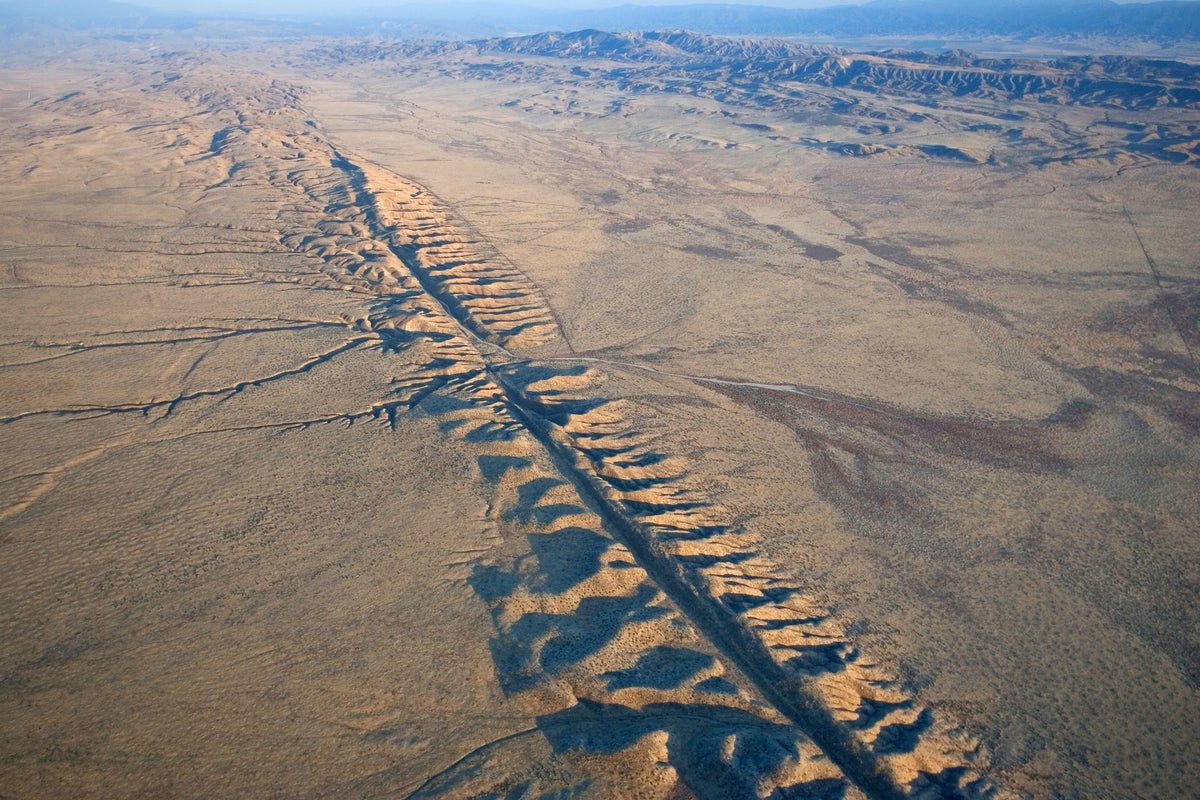New Clues Suggest San Andreas and Cascadia Faults May Produce Synchronized Earthquakes
Samples from the seafloor reveal evidence of several earthquakes along the West Coast’s two major fault zones happening in quick succession over the past 3,000 years
An aerial view of the San Andreas Fault crossing the Carrizo Plain in California.
A team of researchers analyzed a trove of seafloor sediment from the region where the faults meet off the coast of northern California. The researchers’ findings, published recently in Geosphere, reveal that the fault systems have produced several synchronized earthquakes over the past 3,000 years.
If you’re enjoying this article, consider supporting our award-winning journalism by subscribing. By purchasing a subscription you are helping to ensure the future of impactful stories about the discoveries and ideas shaping our world today.
The Cascadia Subduction Zone, where the Juan de Fuca and Gorda plates slide underneath the North American Plate, stretches all the way from Vancouver Island to northern California to meet the San Andreas Fault. That fault extends south for 750 miles along a boundary where the North American and Pacific plates slide past each other.
Most turbidites have coarser sediment layers at the bottom and finer siltlike sediment at the top, similar to what you get when you swirl a bucket of sand at the beach. But the turbidites in samples from the Mendocino Triple Junction “seem to be upside down with all the sand at the top,” Goldfinger says. “And as far as we know, gravity hasn’t changed.”
As they investigated the puzzling features, Goldfinger realized the cores contained two turbidites stacked on top of each other. This provides evidence of two separate earthquake events happening in quick succession—as the first earthquake was settling a layer of silt over the ocean floor, a second shock sent another avalanche of sand over top.
Some of the layered turbidites are so closely spaced that these events could have happened anywhere from within minutes to decades of each other. Analysis of the ages of shells in the sediments suggest there were at least eight large earthquakes along the San Andreas Fault over the past 3,000 years that occurred within decades of significant quakes along the Cascadia Subduction Zone.
Though the Cascadia and San Andreas systems have apparently been linked for millennia, there seems to be some variability when it comes to the timing between successive quakes. Wei, who was not involved in the new study, says it is possible that the two faults could produce shaking within a few years of each other at some point in the future, but more research is needed to gauge how one quake triggers another. “Even if these two faults are synchronized, the time interval between earthquakes can still be decades,” he adds.
The two systems are also not in perfect sync. The team discovered that some temblors, including the 1906 earthquake that devastated San Francisco, were one-off events that were caused exclusively by movements along the northern San Andreas Fault.
CT scan images of turbidites in deep sea sediment cores. On the left, a thin bed of turbidites from a 1906 earthquake. On the right, from an earthquake about 1,500 years ago, the typical “inverted doublet beds” – a doubling or tripling of turbidite thickness. The thick sand up at the top is the San Andreas bed, with the Cascadia bed down below.
But if the two fault systems do end up producing major earthquakes in quick succession, it could cause major disasters all along the West Coast of North America. An initial quake along the Cascadia Subduction Zone would draw recovery resources up to the Pacific Northwest, which would make responding to a subsequent San Andreas earthquake difficult.
Jack Tamisiea is a science journalist based in Washington, D.C., who covers natural history and the environment. Follow Tamisiea on Twitter @jack_tamisiea
If you enjoyed this article, I’d like to ask for your support. Scientific American has served as an advocate for science and industry for 180 years, and right now may be the most critical moment in that two-century history.
I’ve been a Scientific American subscriber since I was 12 years old, and it helped shape the way I look at the world. SciAm always educates and delights me, and inspires a sense of awe for our vast, beautiful universe. I hope it does that for you, too.
If you , you help ensure that our coverage is centered on meaningful research and discovery; that we have the resources to report on the decisions that threaten labs across the U.S.; and that we support both budding and working scientists at a time when the value of science itself too often goes unrecognized.
In return, you get essential news, captivating podcasts, brilliant infographics, , must-watch videos, challenging games, and the science world’s best writing and reporting. You can even gift someone a subscription.
There has never been a more important time for us to stand up and show why science matters. I hope you’ll support us in that mission.
Thank you,
David M. Ewalt, Editor in Chief, Scientific American
Source: www.scientificamerican.com
